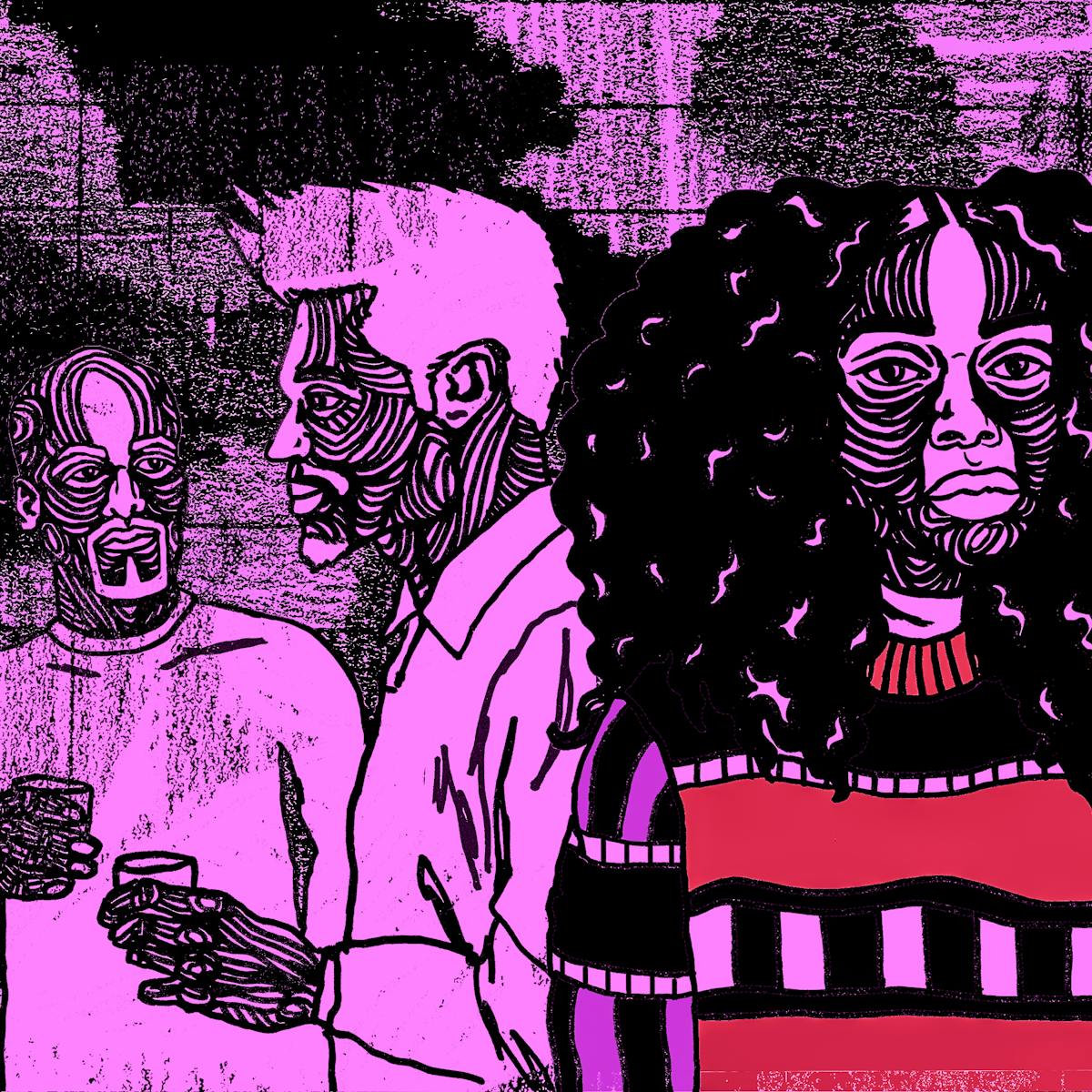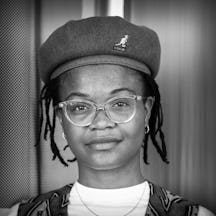For Louisa Adjoa Parker, the racism she experienced as a child was a normal part of life. But adolescence brought mental health problems that she came to realise were a direct consequence. Here she explores what individuals and society can do to acknowledge the harm.
Building resilience in a racist world
Words by Louisa Adjoa Parkerartwork by Olivia Twistaverage reading time 6 minutes
- Article

One of my earliest memories is from when I was aged four, sitting on a playground floor comparing my hands with my friend’s. Her skin was white and smooth; mine was brown, and to my eyes, ugly. She had straight blonde hair, I a short Afro. I was aware of my ‘otherness’ even at that young age; I knew that white equalled good and brown equalled bad.
I grew up during 1970s and ’80s Britain, a time of Thatcherism and anti-immigration, of the National Front and snarling skinheads wearing oxblood Doctor Martens, of our flag, that emblem of Empire, which – along with the people who happily vocalised this message – said to people like myself, “Go home.” For a British-born child of a Ghanaian father and white English mother, there was no other home.
Like most people of colour then, I experienced abuse – hideous insults, heavy with the weight of history and violence. I wasn’t too bothered – it was a normal part of life, something I never spoke about. But abuse pierces your skin, embeds itself inside you. Sometimes it takes decades to recognise trauma. And racism is certainly a form of trauma, one that impacted my mental health enormously. I felt worthless and unwanted by the country I lived in.
Racism in all its guises
One of the many problems with racism is that it comes in different forms. It operates at institutional and structural levels; it’s rooted in colonial history and has been passed down the generations like an ugly heirloom. It’s overt, red-faced and angry and can attack you in the street. And it’s subtle, there in the lack of representation, in the ‘banter’ and ‘harmless’ comments, in the twitching fingers of white people who can’t resist touching Black people’s hair.
Racism is complex and multi-layered, and many people are unaware they hold racist beliefs at an unconscious level. Last year the Guardian’s Bias in Britain poll found evidence suggesting that unconscious bias has a detrimental effect on Britain’s 8.5 million Black, Asian and minority ethnic (BAME) people, something that doesn’t generally show up in racial discrimination data.
Because I’ve lived at the intersection of ‘race’, gender, and domestic abuse, it’s not clear which of these marginalised identities caused the mental health conditions I experience. But I know racism contributed enormously to never feeling safe, never feeling enough, constantly being on guard.
I struggled with my mixed identity during adolescence and began experiencing anxiety and depression, as well as body dysmorphia – I saw an ugly and obese young woman in the mirror. I was acutely aware that whenever I stepped out of the house, I could encounter racism. That strangers would judge me, based solely on the colour of my skin.
During the more ‘politically correct’ nineties and noughties things improved, then the political situation shifted and, especially post-Referendum, racism appears to have become acceptable again.
Living or working in white spaces presents challenges for people of colour. I’ve lived in rural Britain for most of my life. You get used to the stares, the micro-aggressions, feeling exoticised, and the lack of diversity, but sometimes it feels incredibly lonely.
Due to under-representation in many professions, even in urban areas Black and brown people are still often ‘the only one’ at work. It’s incredibly hard for us to challenge racism in white environments. Recently I’ve noticed a strange phenomenon: when people of colour do speak up about racism, it can get flipped around; they are then accused of being ‘racist’ towards white people.
How discrimination affects wellbeing
Frankly, it’s exhausting, and it’s hardly surprising that BAME people experience poorer mental health than our white counterparts. A growing body of evidence suggests people experiencing racism are also more likely to experience poorer treatment and outcomes when interacting with mental health services.
Rianna Walcott, co-editor of the groundbreaking BAME mental health anthology ‘The Colour of Madness’, wrote recently about barriers Black people face when accessing mental healthcare. We’ve known all this for some time, yet in spite of the reports and initiatives, glaring inequalities remain.
It’s obvious that any form of discrimination will impact your emotional wellbeing. But racism can affect you even when it’s not happening to you. The global and transgenerational trauma impact is huge. For people of colour, it can be triggering to witness Black and brown bodies being abused, brutalised or killed.
Where I live now, I mainly experience micro-aggressions. Yet the knowledge that this is happening to others – regionally, nationally and globally – causes me great distress. I can’t bear to watch footage of any racial violence.
Racism can affect you even when it’s not happening to you. The global and transgenerational trauma impact is huge.
You can’t get away from racism. With other forms of abuse, it’s possible to find a safe space and begin to heal. As people of colour, many of us are triggered and retraumatised throughout our lives. And what support is available?
I have as yet been unable to receive a mental health diagnosis from a psychiatrist; however, therapists have suggested – and I believe – that I have complex PTSD. Last year, after a nine-month wait, I received cognitive analytic therapy with a nice white woman. I had to explain to her that it wasn’t OK to use the term ‘coloured’ to describe me, and yes, it was OK to say ‘Afro’. A handful of such sessions is not going to undo years of trauma anyway, let alone when ‘race’ comes into it. My dream would be to work with a BAME therapist who specialises in complex trauma.
Telling our stories
So, what can we do, collectively, to improve BAME mental health? A better understanding among healthcare professionals that racism is without doubt a trauma is key. (And that when intersected with other oppression, the impact will be greater.)
We are beginning to understand the long-term emotional and physical impacts of abuse, such as witnessing domestic violence in childhood. Yet I’m not aware of any UK-based work that has been carried out on adult survivors of racism. We also urgently need better BAME representation in mental healthcare – how can we feel we’ll receive proper care if the only therapists available are white?
We need to keep this conversation going, especially in the current political climate. And we need to find ways to promote resilience in ourselves and others. Self-care tips suggested by Professor Roberta K Timothy, who specialises in anti-oppression and anti-colonial approaches to mental health, include: building safe spaces; creating an ongoing healing plan; having ‘alone time’; expressing emotions; having a physical release; and creating community support.
For those who are able to, telling our stories is an important part of healing. As psychologist Guilaine Kinouani writes in the foreword to ‘The Colour of Madness’, “In a world that orders you to keep strong… our tears are political… Being vulnerable is revolutionary. It is deeply humanising.”
About the contributors
Louisa Adjoa Parker
Louisa is a writer of English and Ghanaian heritage from south-west England. Her focus is on telling the stories of marginalised voices, and her poetry, fiction, BAME history and articles have been widely published. Her third poetry collection, ‘How to Wear a Skin’, was published by Indigo Dreams in 2019. She has been highly commended by the Forward Prize and twice shortlisted by the Bridport Prize.
Olivia Twist
Olivia Twist is an illustrator, arts facilitator and lecturer from east London with an MA in Visual Communication from the Royal College of Art. The key threads that can be found in her work are place, the mundane and overlooked narratives. Her striking visual language is comprised of a myriad of esoteric layers informed by a propensity for human-centered research methodologies.

